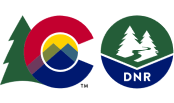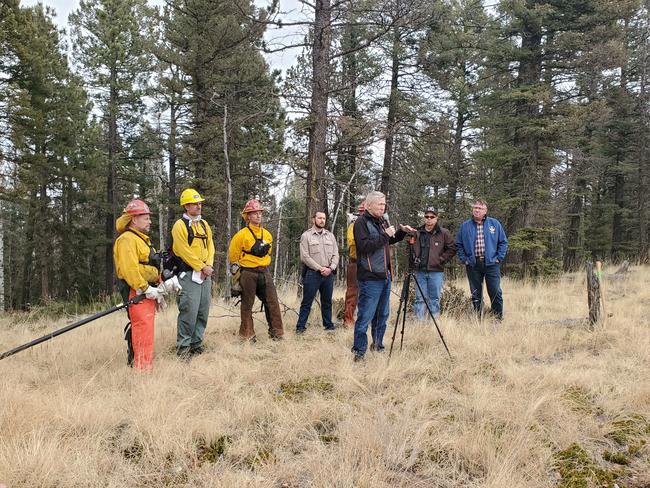The Colorado Department of Natural Resources (DNR) announced today the launch of the Colorado Strategic Wildfire Action Program and highlighted the special collaboration with their partners, the Department of Corrections (DOC), State Wildland Inmate Fire Team (SWIFT).
Colorado Strategic Wildfire Action Program (COSWAP) was created after the devastating 2020 fire season by the Colorado legislature through the bi-partisan supported SB21-258. COSWAP is designed to quickly move state stimulus funds to start on-the-ground work on fuels reduction projects including funds for landscape scale strategic wildfire mitigation projects in strategic wildfire prone communities in Colorado.
“Colorado is one lightning strike, one unattended fire, and one drought season away from our next mega fire, said Dan Gibbs, Executive Director, Colorado Department of Natural Resources. “The devastating 2020 fire season taught us that the status quo of our forest health and wildfire mitigation programs were no longer going to cut it and our state and federal partners needed to do more, and quickly.”
“Thanks to the leadership of Governor Polis, bi-partisan support in the Colorado legislature, and strong inter-agency collaboration, we have launched the Colorado Strategic Wildfire Action Program, identified priority areas, and are going to be moving funds to on-the-ground projects and deploying hand crew teams from CDOC and the Colorado Youth Corps within months of legislation being signed”, Gibbs added.
The COSWAP is housed under DNR in coordination with the Colorado State Forest Service (CSFS) and the Division of Fire Prevention and Control (DFPC) in the Department of Public Safety. It includes a special collaboration with State Wildland Inmate Fire Teams (SWIFT) within the Department of Corrections (DOC) and Colorado Youth Corps Association (CYCA) to be deployed as hand crew teams to jump-start critical on-the-ground forest health and wildfire mitigation work throughout Colorado.
“We are excited about the opportunity to partner with DNR to not only provide an important public service through this mitigation work, but also to offer incarcerated individuals an opportunity to gain skills, save money, and prepare for a successful re-entry into the community once their sentence is complete,” said DOC Executive Director Dean Williams. “Many of these crew members have responded to some of the largest natural disasters in the state and they find purpose and dignity in the work they do. With the increased risk of fires in Colorado and across the nation, we know that this partnership with DNR will help provide critical support.”
Since its inception in 2002, SWIFT crews and fire mitigation teams have been involved in relief for most of Colorado’s biggest disasters. From the devastating Northern Colorado floods to the recent Cameron Peak (2020) and Morgan Creek (2021) Fires, these teams have helped to safeguard land, life and homes. There are currently 95 incarcerated individuals who are working in the SWIFT program. The Department anticipates increasing the number of crews to include 160 incarcerated individuals to help meet project needs.
In addition to fighting fires, the crews are trained in sustainable mitigation development and maintenance following the standardized methods of construction commonly used by state, federal and local land management agencies. The crew members bring knowledgeable and willing hands to the task.
“Developing partnerships with agencies such as Dept of Natural Resources, Colorado Parks and Wildlife, Colorado State Forest Service, Dept of Corrections and local counties is critical in accomplishing forest health and fire mitigation goals within Teller County. And let’s not forget private land owners whether they own 1 acre or 500 acres. Collaboration is the key to accomplishing such large projects,” said John Geerdes, Executive Director, Coalition for the Upper South Platte. “Coalition for the Upper South Platte is a non-profit that is primarily grant funded and focuses on pre-fire mitigation, forest health, post fire rehabilitation and more. We have used SWIFT crews in the past when our work called for hand crews rather than mechanical thinning. They have always done an outstanding job for us and I look forward to ways we can use them in the future under this new program.”
A key aspect of the COSWAP was the formation of a Rapid Fuels Reduction Assessment (RFRA) team which was a unique partnership composed of experts from the Department of Natural Resources, Colorado State Forest Service, Division of Fire Prevention and Control, U.S. Forest Service, Bureau of Land Management, National Parks Service, and the Colorado Forest Restoration Institute at Colorado State University.
The team was instigated by a bi-partisan letter from state, federal, and federal representatives asking for federal resources and partnership to address Colorado’s pressing forest health and wildfire mitigation challenges.
The RFRA team conducted a comprehensive risk analysis to identify the most strategic landscapes in the state for wildfire mitigation and fuel reduction projects.
Strategic Focus Areas include: Boulder, Douglas, El Paso, Jefferson, Larimer, La Plata and Teller counties, plus Rocky Mountain Restoration Initiative focal areas.
The pilot project at Dome Rock State Wildlife Area highlighted an important initiative for Colorado Parks and Wildlife to conduct forest health projects that will benefit important wildlife habitat while also providing important thinning and mitigation work to protect local communities at risk.
“This work at Dome Rock will improve the habitat for bighorn sheep that lamb in the wildlife area,” said Cody Wigner, CPW Area Wildlife Manager for the Pikes Peak region. “Thinning will open up the forest canopy and create greater visibility for the sheep and other wildlife. That will make them more comfortable and more likely to use the wildlife area because they can spot predators more easily. Improved habitat means more wildlife which is the ultimate goal for our state wildlife areas.”
SB21-258 was a result of priorities set out in the Colorado Recovery Plan by the Governor and the Colorado legislature, allocating a total of $25 million of stimulus funds to immediately address Colorado’s forest health and wildfire challenges. The $17 Million for COSWAP project implementation included more than doubling DOC SWIFT crews and significantly increasing Colorado Youth Corps forest health mitigation work throughout Colorado. A large portion of funds will also go to landscape-scale wildfire mitigation projects conducting critical work such as reducing hazardous fuels, forest thinning, developing fuel breaks and clearing evacuation routes. All funds must be obligated by June 30, 2023.
Additional SB21-258 funds gave long-term sustainable support to the Colorado State Forest Service Forest Restoration & Wildfire Risk Mitigation (FRWRM) Grant Program, a complimentary fund and new investment for CSFS Forest Business Loan Fund to support Colorado timber businesses. Additionally the bill called for an organizational assessment of state wildfire mitigation programs which also will be led by staff from DNR in partnership with the Colorado State Forest Service and Division of Fire Prevention and Control.
“This partnership represents the best of the Colorado spirit, putting young people to work while protecting the lives and livelihoods of millions of Coloradans,” said Scott Scott Segerstrom, Executive Director, Colorado Youth Corp Association. “This investment from DNR will help build the next generation of wildland firefighters, grow our outdoor recreation economy, and respond to the existential threat of climate change. Young people serving in their local communities for the benefit of all is something for which every Coloradan can be proud.”
Learn more about the Colorado Strategic Wildfire Action Program
###

